Making the right moves Understand article
Cell’s movements are important in health and diseases, but their speed is the crucial point for the 2013 World Cell Race organised by Daniel Irimia.
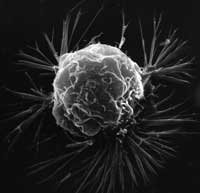
Image courtesy of public
domain, credit: Bruce Wetzel
and Harry Schaefer/National
Cancer Institute)
It might not be the most exciting spectator sport, but the World Cell Race is the equivalent of the Olympics for biologists. This year’s race was won by a breast cancer cell line that reached top speeds of 50 μm.h-1. It might sound frivolous, but understanding cell motility, or the ability of cells to move, is important for both health and disease. Cell motility is a factor in cancer, immune response, wound healing and embryo development, as well as other biological functions. However, scientists still don’t fully understand the process and there are no drugs that can specifically speed up or slow down cell movement.
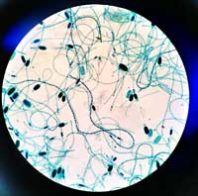
of filamentous cyanobacteria
found in terrestrial and
aquatic environments.
Image in the public domain.
Source: Wikimedia
Cells need to move for various reasons – to find food, intercept threats, escape an unsuitable environment or colonise a new one. Some cells, including sperm cells and many bacteria, can swim rapidly using tail-like flagellae.
Other cells, like the ones included in the cell race, move in a much less dramatic way by creating membrane protrusions (called pseudopodia), a bit like reaching fingers, which attach themselves to a surface and then pull the rest of the cell along behind them (see figure 1). A cell moving this way can typically cover 1-2 times its own length per hour. To put this into context, a snail moves at around 20 body lengths per hour; in his record-breaking sprint at the 2012 Olympic Games, Usain Bolt ran at the equivalent of 18 000 body lengths per hour.
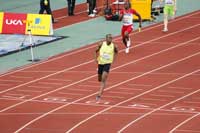
Grand Prix in 2009
Image courtesy of Paul Foot
This movement might not be fast, but it is incredibly important. For example, during embryo development, precisely orchestrated cell movements allow the formation of the distinct layers of tissue that will ultimately grow into the mature organs, systems and body parts. Incorrect cell migration during embryo development can lead to a range of disabilities and birth defects, including spina bifida. Elsewhere in the body, wounds heal as specialised stem cells move into the injury site to regenerate blood vessels, knit the tissues together and build new skin.
The World Cell Race 2013
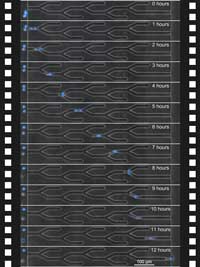
Figure 1: The progress of the
fastest cell, from the MDA MB
231 S1 breast cancer cell line,
during the World Cell Race
2013. The cell’s nucleus has
been stained with a non-
toxic blue dye (Hoechst dye).
Image courtesy of Daniel
Irimia, Massachusetts General
Hospital
The ‘race track’ is an intricate maze of channels just 10 μm wide, arranged on a specially made plate. Created using a micro-fabrication technique called soft lithography, the maze walls are made from silicone, an inert material that can be moulded to precise and intricate shapes.
Labs all over the world were invited to send a sample of their speediest cells for inclusion in the race. The cells were stained with a nontoxic blue dye to make them easier to see and then placed at one end of the maze.
Most cells move only in response to specific stimuli – for example, towards nutrients – but all the competitors in this race were cancer cells, which make self-directed movements into the maze channels and usually move faster than non-cancer cells.
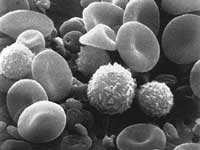
cells in centre
Image courtesy of public
domain, credit: Bruce Wetzel
and Harry Schaefer/National
Cancer Institute
The plates were photographed every 15 minutes for 24 hours and the winner was the culture with the most cells reaching the far end of the 600 μm long track. You can see some of the cells in action on the World Cell Race 2013 websitew1. In scenes reminiscent of the classic tale ‘The Tortoise and the Hare’, the winning culture, a breast cancer cell line called MDA MB 231 S1, wasn’t the fastest, but moved steadily throughout the race. A cell line from sarcoma (cancer of the connective tissues), MFH 137, was slow to get going and was ultimately the fastest mover, but fewer cells crossed the finish line, relegating it to second place.
The World Cell Race is now in its third year. In the most recent challenge, the organisers raced the cells through mazes with corners and dead ends to test the ‘intelligence’ of the cells as well as their speed. This is a more accurate representation of what happens in vivo, where migrating cells have to squeeze through intercellular spaces and orient themselves in three dimensions.
In sickness and in health
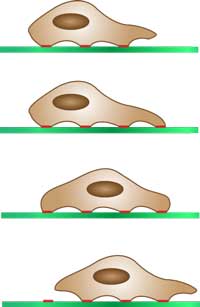
motility. a) A protrusion of the
membrane called a
pseudopodium forms at the
leading edge (right) of the
cell; b) the pseudopodium
attaches to the surface via
membrane proteins called
integrins (red); c) the
main body of the cell is pulled
forward; and d) the trailing
edge of the cell detaches from
the surface and the cycle
begins again.
Image courtesy of Alexandre Saez
via Wikimedia Commons
It is no surprise that a breast cancer cell triumphed in this race. Cancer cells are among the fastest moving mammalian cells. Cancer has a tendency to spread from the initial tumour site and begin growing in other parts of the body in a process called metastasis. Whereas other motile cells move towards or away from stimuli (such as nutrients or light), cancer cells make self-guided movements to escape small spaces and don’t seem to know when to stop. It could take as little as one month for a cancer cell to move 10 cm from a primary tumour in the breast to lodge in a nearby lymph node. Cancer that has spread is much harder to treat and often proves fatal, so understanding and ultimately finding ways to stop the movement of cancer cells could save lives.
There may be other situations where encouraging cells to move faster would be beneficial. White blood cells are a key part of our immune response. They move rapidly to sites of infection to engulf and destroy microbes, actively choosing the shortest route to reach their target. Patients with severe burns are more prone to infections, apparently because their white blood cells lose their internal compass and are unable to orient themselves, slowing their progress towards the pathogen. Therefore, drugs that could boost the speed or targeting efficiency of white blood cells might be very useful for both preventing and treating infections.
However, boosting the response of white blood cells isn’t always desirable. In chronic inflammatory diseases such as rheumatoid arthritis and asthma, white blood cells misinterpret chemical signals and migrate into healthy tissue, causing pain, inflammation and damage. In these cases, finding a way to suppress this cell migration would be desirable.
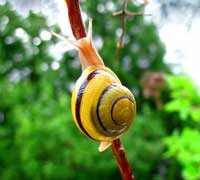
(Cepaea hortensis)
Image courtesy of Mad Max,
Kirkland, Washington
There are still many gaps in our understanding of how and why cells move. Daniel and his fellow organisers hope that the World Cell Race will raise awareness of the importance of cell motility and encourage greater co-operation between biologists and engineers. They also hope their methods might lead to standardised ways of measuring cell motility, making it easier to study the impact of drugs or other means of controlling this movement.
After any race, the competitors evaluate their performance and begin to plan for the next challenge. The organisers have already set the date for the next World Cell Race: 14 November 2014. In the next race, white blood cells will also be eligible to race alongside cancer cells in an epic battle of good against evil. The fast-moving slime mould Dictyostelium discoideum also gets its own race on 21 March 2014. You can subscribe for updates on the World Cell Race website.w1
If you would like to investigate cell migration in your classroom, slime moulds, especially Dictyostelium, or white blood cells are a good place to start. Dictyostelium is fast-growing and easy to maintain on nutrient agar at room temperature. White blood cells are easy to see with a typical school microscope, and horse blood can be obtained from many educational suppliers.
Try setting up a sample of Dictyostelium or horse blood under a microscope and taking photographs at regular intervals with a fixed camera. Then compare the images to see if you can catch the cells moving. Putting a gentle heat source, such as a desk lamp with an incandescent bulb, at one side of the slide might help, because both cell types respond to temperature (thermotaxis) and Dictyostelium responds to light (phototaxis).
Web References
- w1 – For more information about the World Cell Race 2013, visit its website.
Resources
- You can watch videos of the race and other fast-moving cells on Daniel Irimia’s Youtube channel.
- To read more about previous World Cell Races, visit the website of the 2011 challenge.
Review
This enjoyable article addresses a basic topic of animal cells: motility. Although it is widely known that animal cells can move, the deep understanding of cell motility “is really important for both health and disease”, as the authors claim. Here, we have a valuable resource to learn more about motility from a fun and inspiring approach. The idea of a World Cell Race could shock us for a moment, but immediately we take in its importance and significance. The subject of this article is related to other important biological topics such as immunology, embryo development and cancer.
The article could also be useful for raising discussions about the daily work of scientists, sharing of knowledge among laboratories, and the new technologies that allow the speeds of different cell lines to be measured and compared.
Suitable comprehension questions could include:
- What is the importance of the study of cell motility?
- What is the relationship between cell motility and cell migration?
- What is the aim of the World Cell Race?
- Why does the shape of the race track change from one year to another in the World Cell Race?
- Give some examples of cells in which it would benefit researchers to stop motility or to encourage motility.
- Some cells make self-guided movements and don’t seem to need any stimuli to move. What kinds of cells are they? Why are they considered to pose a problem?
- Using the race track, how would you prove the effect of a drug on cell motility?
Ana Molina, IES Gil y Carrasco, Spain





